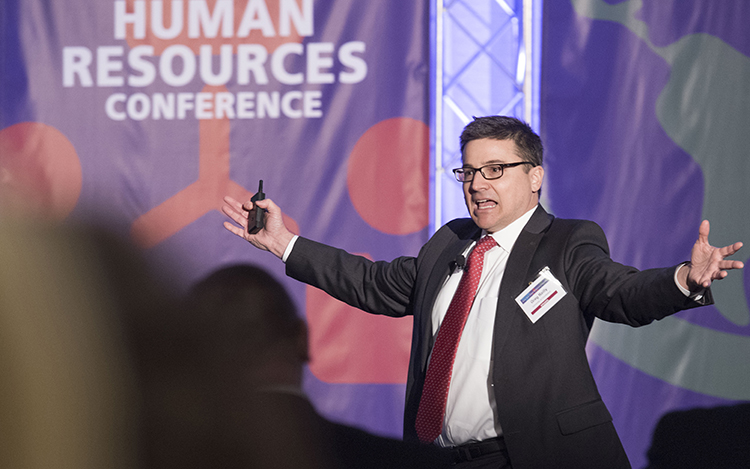
Human Resources Professionals Taking On Larger, More Strategic Roles, Professor Greg Reilly Tells CBIA Conference Members
The most sought-after human resources professionals today are full partners in the strategic leadership team, identifying weaknesses within an organization and hiring the right people to make a company more competitive and robust.
That was the insight that management professor Greg Reilly shared with 150 participants during the Connecticut Business & Industry Association’s (CBIA) Human Resources Conference. Reilly was the keynote speaker at last month’s event at the Crown Plaza Hotel in Cromwell.
The emphasis of his presentation was the distinction between good and bad strategy in human resources. A bad strategy avoids addressing organizational problems, and substitutes inspiration for action, he said. Blockbuster, for example, ignored the threats posted by Netflix, which ultimately led to the company’s demise, he said. Reilly said a good strategy takes a critical look at a company’s weaknesses and seeks solutions, builds on advantages and pursues attractive markets.
In the presentation, Reilly shared one example of using an innovative hiring strategy in professional football. Unlike other NFL teams, the Philadelphia Eagles recently described a draft strategy that emphasizes players who have earned college degrees.
“The team has decided to place a high value on smart players, because the Eagles’ approach to the game is particularly complex, and smart players are especially valuable in such a system,” Reilly said.
Reilly also shared the example of Caterpillar Inc., a worldwide manufacturer of construction machinery and equipment, and its application of strategy ideas to attracting technical repair talent. The company focused specifically on understanding and communicating the distinct benefits potential technicians would gain by joining Caterpillar relative to their most likely alternatives of going to college or joining the military, Reilly said.
“In progressive companies today we’re seeing human resources experts take on a broader approach that recognizes people as a critical resource,” Reilly said. “Now we have human resources professionals thinking strategically about what we can do with our people to beat our competitors.”
That is a theme that runs through all of the courses in UConn’s Master of Science in Human Resources Management (MSHRM) program, which was completely revamped last year.
The program targets human resources professionals looking to move up in the ranks, as well as people who are interested in transitioning to human resources from other fields. It is an MBA-level curriculum for people who are confident in their path. The hybrid program offers online learning and monthly classes at the School of Business’ downtown Hartford campus, said Reilly, who is the academic director for the graduate programs in human resource management.
“Many older programs developed from traditional industrial relations between unions and management, which oftentimes were very confrontational,” he said. “Today’s human resources experts can help a company “win” in their markets, whether that is finding new business partners, new investors or new employees.”
Reilly is active in executive training and has led courses on developing strategy, performance measurement, strategic human resources and strategic financial management throughout the United States and abroad. His research has been published in numerous top tier academic journals and highlighted in the Harvard Business Review. His clients have included GE Energy, Caterpillar, Travelers, University of Michigan Cardiovascular Center and Carhartt Inc.
Reilly finished his presentation by urging the audience to take a more scientific approach to human resources.
“Innovative companies, including Wal-Mart and Credit Suisse, are using scientific research methods to tell managers who is most likely to quit,” he said. The “retention predictor” data is designed to give managers warning so they can prepare for changes in personnel. Among the data that is evaluated is job tenure, employee surveys, performance reviews, personality tests and communication patterns. One company, for instance, found that a worker’s pay and relationship with his or her superiors mattered less than the need to feel connected to a work team. The implications for the use of science to develop a more productive and happy workplace are adding to the excitement for those in the field, Reilly said.